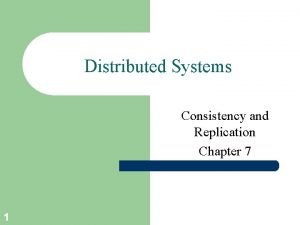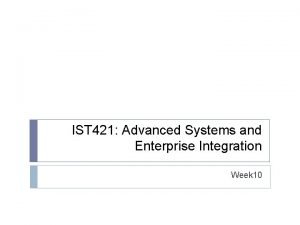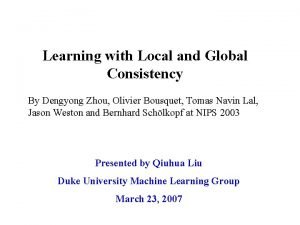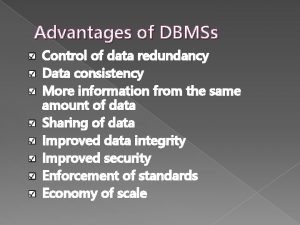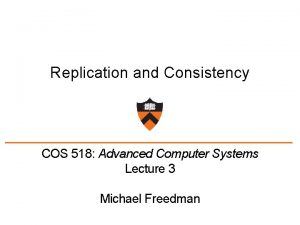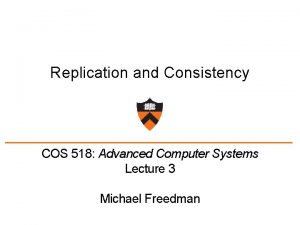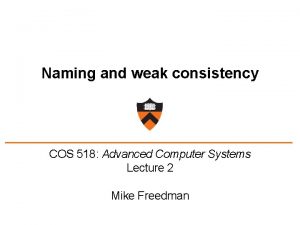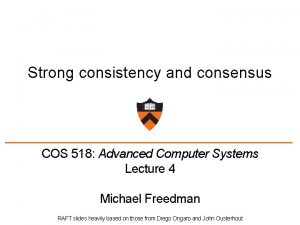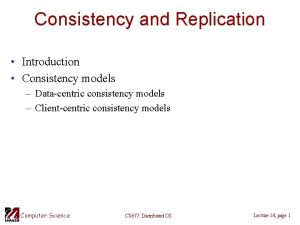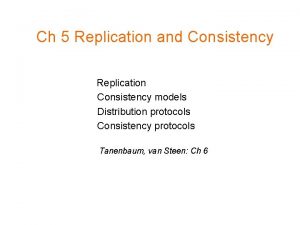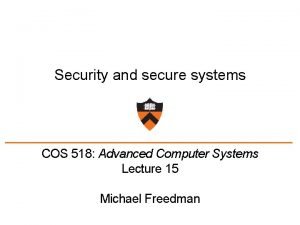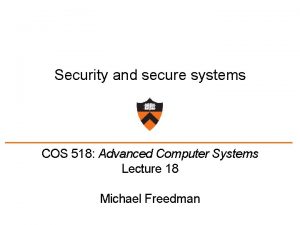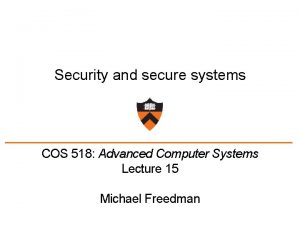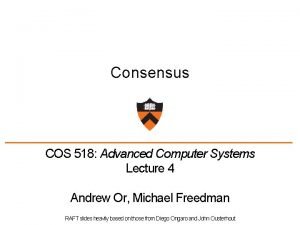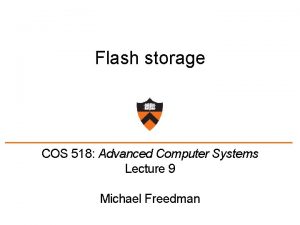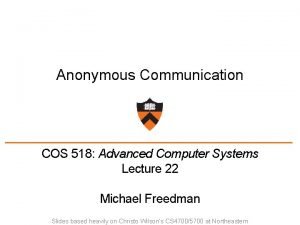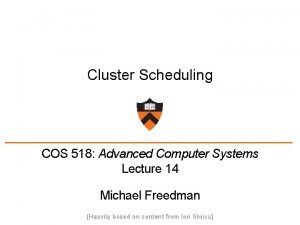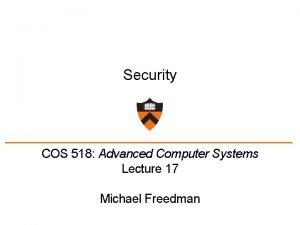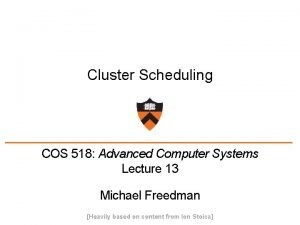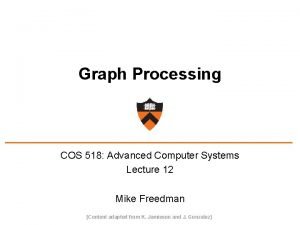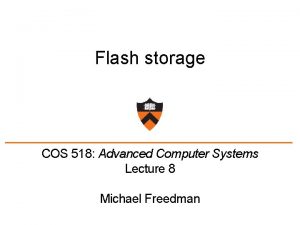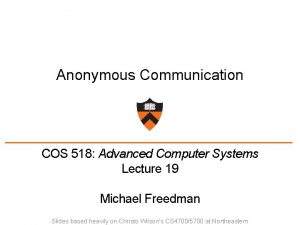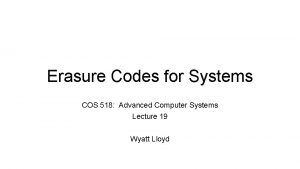Replication and Consistency COS 518 Advanced Computer Systems

































- Slides: 33

Replication and Consistency COS 518: Advanced Computer Systems Lecture 3 Michael Freedman

Correct consistency model? A B • Let’s say A and B send an op. • All readers see A → B ? • All readers see B → A ? • Some see A → B and others B → A ?

Time and distributed systems • With multiple events, what happens first? A shoots B B shoots A A dies B dies

Just use time stamps? p Time server, S • Clients ask time server for time and adjust local clock, based on response • How to correct for the network latency? RTT = Time_received – Time_sent Time_local_new = Time_server + (RTT / 2)

Is this sufficient? • Server latency due to load? – If can measure: Time_local_new = Time_server + (RTT / 2 + lag) • But what about asymmetric latency? – RTT / 2 not sufficient! • What do we need to measure RTT? – Requires no clock drift! • What about “almost” concurrent events? – Clocks have micro/milli-second precision

Order by logical events, not by wall clock time 6

Correct consistency model? A B • Let’s say A and B send an op. • All readers see A → B ? • All readers see B → A ? • Some see A → B and others B → A ?

“Lazy replication” OK A A • Acknowledge writes immediately • Lazily replicate elsewhere (push or pull) • Eventual consistency: Dynamo, …

“Eager replication” OK A • On a write, immediately replicate elsewhere • Wait until write committed to sufficient # of nodes before acknowledging

Consistency models Strong consistency Causal Consistency Sequential Consistency Eventual consistency 10

Strong consistency • Provide behavior of a single copy of object: – Read should return the most recent write – Subsequent reads should return same value, until next write • Telephone intuition: 1. Alice updates Facebook post 2. Alice calls Bob on phone: “Check my Facebook post!” 3. Bob read’s Alice’s wall, sees her post 11

Strong Consistency? write(A, 1) success 1 read(A) Phone call: Ensures happens-before relationship, even through “out-of-band” communication 12

Strong Consistency? write(A, 1) success 1 read(A) One cool trick: Delay responding to writes/ops until properly committed 13

Strong Consistency? This is buggy! write(A, 1) success eager replication 1 committed read(A) • Isn’t sufficient to return value of third node: It doesn’t know precisely when op is “globally” committed • Instead: Need to actually order read operation 14

Strong Consistency! write(A, 1) success 1 read(A) Order all operations via (1) leader, (2) consensus 15

Strong consistency = linearizability • Linearizability (Herlihy and Wang 1991) 1. All servers execute all ops in some identical sequential order 2. Global ordering preserves each client’s own local ordering 3. Global ordering preserves real-time guarantee • All ops receive global time-stamp using a sync’d clock • If tsop 1(x) < tsop 2(y), OP 1(x) precedes OP 2(y) in sequence • Once write completes, all later reads (by wall-clock start time) should return value of that write or value of later write. • Once read returns particular value, all later reads should return that value or value of later write.

Intuition: Real-time ordering write(A, 1) success 1 committed read(A) • Once write completes, all later reads (by wall-clock start time) should return value of that write or value of later write. • Once read returns particular value, all later reads should return that value or value of later write. 17

Weaker: Sequential consistency • Sequential = Linearizability – real-time ordering 1. All servers execute all ops in some identical sequential order 2. Global ordering preserves each client’s own local ordering • With concurrent ops, “reordering” of ops (w. r. t. real-time ordering) acceptable, but all servers must see same order – e. g. , linearizability cares about time sequential consistency cares about program order

Sequential Consistency write(A, 1) success 0 read(A) In example, system orders read(A) before write(A, 1) 19

Valid Sequential Consistency? x • Why? Because P 3 and P 4 don’t agree on order of ops. Doesn’t matter when events took place on diff machine, as long as proc’s AGREE on order. • What if P 1 did both W(x)a and W(x)b? - Neither valid, as (a) doesn’t preserve local ordering

Even Weaker: Causal consistency • Potentially causally related operations? – R(x) then W(x) – R(x) then W(y), x ≠ y • Necessary condition: Potentially causally-related writes must be seen by all processes in the same order – Concurrent writes may be seen in a different order on different machines

Causal consistency • Allowed with causal consistency, but not with sequential • W(x)b and W(x)c are concurrent – So all processes don’t see them in the same order • P 3 and P 4 read the values ‘a’ and ‘b’ in order as potentially causally related. No ‘causality’ for ‘c’.

Causal consistency • Why not sequentially consistent? – P 3 and P 4 see W(x)b and W(x)c in different order. • But fine for causal consistency – Writes W(x)b and W(x)c are not causally dependent • Write after write has no dependencies

Causal consistency x § A: Violation: W(x)b potentially dependent on W(x)a § B: Correct. P 2 doesn’t read value of a before W

Causal consistency • Requires keeping track of which processes have seen which writes – Needs a dependency graph of which op is dependent on which other ops – …or use vector timestamps! See COS 418: https: //www. cs. princeton. edu/courses/archive/fall 17/cos 418/docs/L 4 -time. pptx

Implementing strong consistency 26

OK A Recall “eager replication” • On a write, immediately replicate elsewhere • Wait until write committed to sufficient # of nodes before acknowledging • What does this mean? 27

Two phase commit protocol 1. C P: “request write X” Client C 2. P A, B: “prepare to write X” 3. Primary P A, B P: “prepared” or “error” 4. P C: “result write X” or “failed” 5. P A, B: “commit write X” Backup A B 28

State machine replication • Any server is essentially a state machine – Operations transition between states • Need an op to be executed on all replicas, or none at all – i. e. , we need distributed all-or-nothing atomicity – If op is deterministic, replicas will end in same state 29

Two phase commit protocol 1. C P: “request <op>” Client C 2. P A, B: “prepare <op>” 3. Primary P A, B P: “prepared” or “error” 4. P C: “result exec<op>” or “failed” 5. P A, B: “commit <op>” Backup A B What if primary fails? Backup fails? 30

Two phase commit protocol 1. C P: “request <op>” Client C 2. P A, B: “prepare <op>” 3. Primary P A, B P: “prepared” or “error” 4. P C: “result exec<op>” or “failed” 5. P A, B: “commit <op>” Backup A B “Okay” (i. e. , op is stable) if written to > ½ backups 31

Two phase commit protocol Client C >½ nodes Primary P • Commit sets always overlap ≥ 1 node Backup A B • Any >½ nodes guaranteed to see committed op 32

Wednesday class Papers: Strong consistency Lecture: Consensus, view change protocols 33
 Distributed data store
Distributed data store Replicated data consistency explained through baseball
Replicated data consistency explained through baseball Gezang 161
Gezang 161 Bioflix activity dna replication lagging strand synthesis
Bioflix activity dna replication lagging strand synthesis Oracle data replication
Oracle data replication Memory consistency
Memory consistency Diketahui sin a = 0,6 dan a sudut lancip adalah…
Diketahui sin a = 0,6 dan a sudut lancip adalah… Cos c -cos d
Cos c -cos d Nyatakan dalam bentuk jumlah atau selisih 2 sin a cos 3a
Nyatakan dalam bentuk jumlah atau selisih 2 sin a cos 3a Funções trigonométricas
Funções trigonométricas Intreccio narrativo
Intreccio narrativo Montaggio incrociato testo narrativo
Montaggio incrociato testo narrativo Inverse trigonometric ratios table
Inverse trigonometric ratios table Nilai dari 2 sin 112 5 cos 112 5
Nilai dari 2 sin 112 5 cos 112 5 Sudut 320 derajat berada pada kuadran ke
Sudut 320 derajat berada pada kuadran ke Nnemp
Nnemp Advanced fueling systems
Advanced fueling systems Cs598
Cs598 Advanced fluid power
Advanced fluid power Tom kilcer advanced ag systems
Tom kilcer advanced ag systems Ist 421
Ist 421 Advanced embedded systems
Advanced embedded systems Projection slice theorem
Projection slice theorem Advanced cooling systems inc
Advanced cooling systems inc Computer architecture
Computer architecture Advanced topics in computer science
Advanced topics in computer science Advanced computer graphics
Advanced computer graphics Advanced computer forensics
Advanced computer forensics Fastbloc
Fastbloc Dengyong zhou
Dengyong zhou It is the feel appearance of a surface or substance
It is the feel appearance of a surface or substance Plastic limit formula
Plastic limit formula Data redundancy and consistency
Data redundancy and consistency Vision eloquence and consistency
Vision eloquence and consistency
